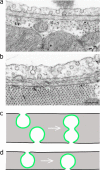The role of lipid species in membranes and cancer-related changes
- PMID: 32314087
- PMCID: PMC7311489
- DOI: 10.1007/s10555-020-09872-z
The role of lipid species in membranes and cancer-related changes
Abstract
Several studies have demonstrated interactions between the two leaflets in membrane bilayers and the importance of specific lipid species for such interaction and membrane function. We here discuss these investigations with a focus on the sphingolipid and cholesterol-rich lipid membrane domains called lipid rafts, including the small flask-shaped invaginations called caveolae, and the importance of such membrane structures in cell biology and cancer. We discuss the possible interactions between the very long-chain sphingolipids in the outer leaflet of the plasma membrane and the phosphatidylserine species PS 18:0/18:1 in the inner leaflet and the importance of cholesterol for such interactions. We challenge the view that lipid rafts contain a large fraction of lipids with two saturated fatty acyl groups and argue that it is important in future studies of membrane models to use asymmetric membrane bilayers with lipid species commonly found in cellular membranes. We also discuss the need for more quantitative lipidomic studies in order to understand membrane function and structure in general, and the importance of lipid rafts in biological systems. Finally, we discuss cancer-related changes in lipid rafts and lipid composition, with a special focus on changes in glycosphingolipids and the possibility of using lipid therapy for cancer treatment.
Keywords: Cancer; Caveolae; Endocytosis; Leaflet interdigitation; Membrane domains; Molecular dynamic simulation.
Figures



References
Publication types
MeSH terms
Substances
LinkOut - more resources
Full Text Sources
Medical

